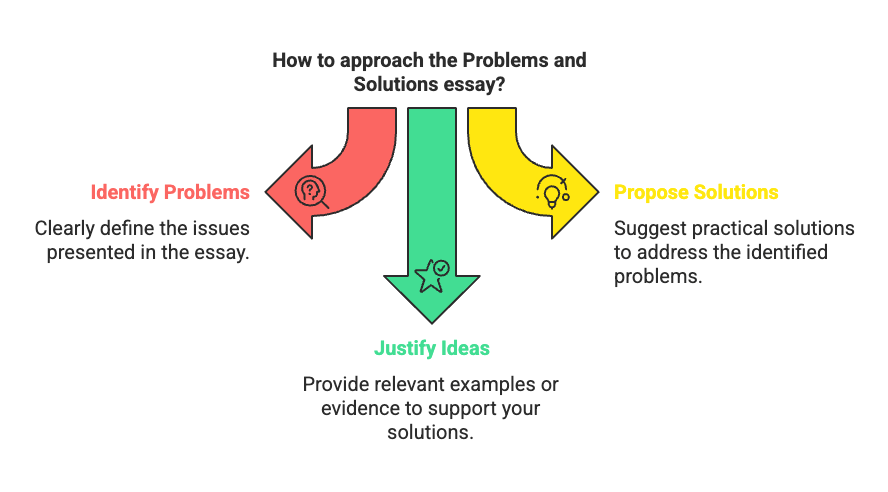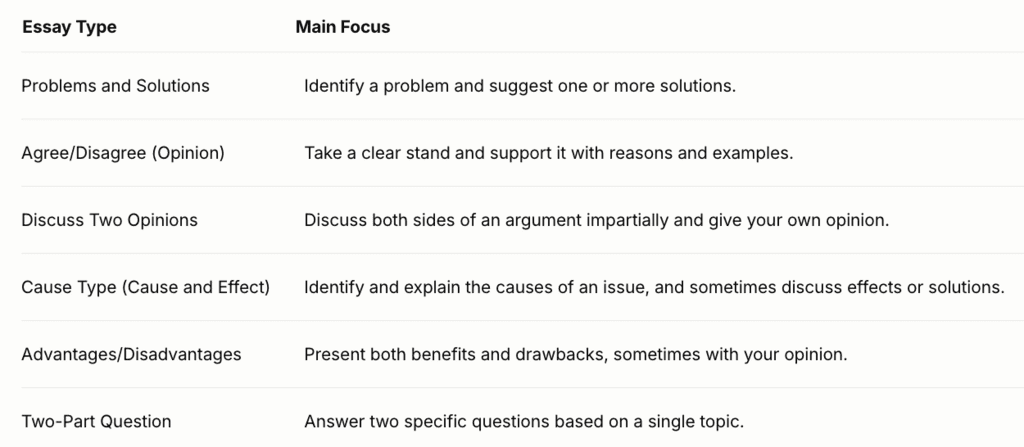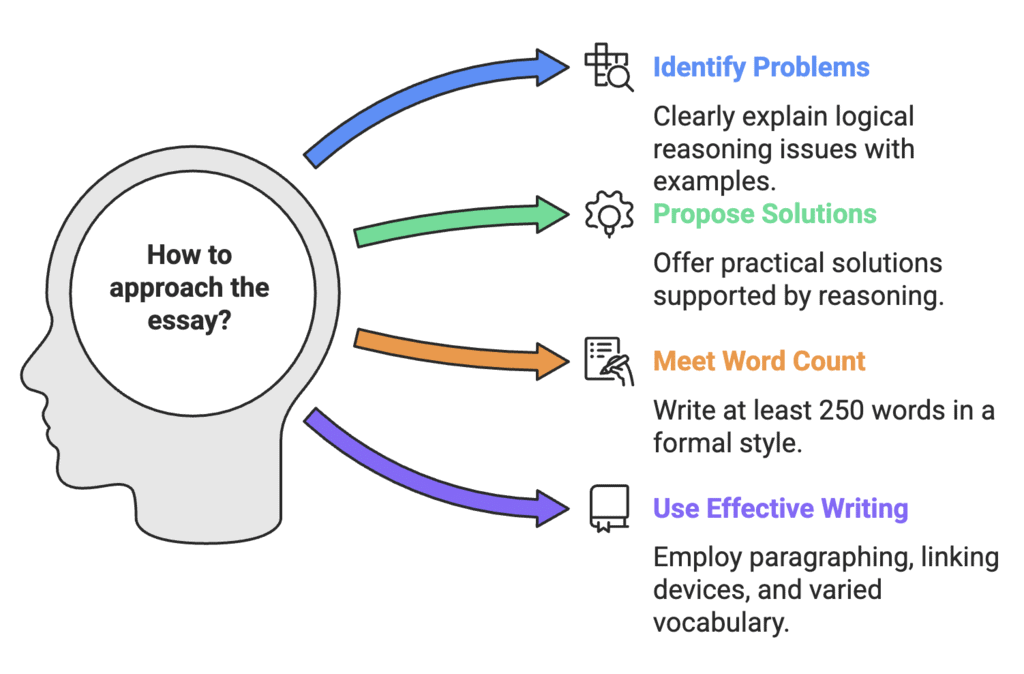How to Write an IELTS Task 2 Essay: Problems & Solutions Type | Solved Essays for IELTS PDF Download
| Table of contents |

|
| What to Keep in Mind When Writing This Type of Essay |

|
| What the Question Looks Like |

|
| What the Examiner Expects |

|
| Recommended Structure |

|
| Tips to Score High |

|
- The Problems and Solutions essay is a common question type in IELTS Writing Task 2.
- In this essay, you are presented with a specific issue or problem, and your task is to identify its key problems and propose practical solutions to address them.
- You are expected to analyse the issue clearly, explain why the problems exist, and suggest feasible solutions, supported by relevant examples or evidence.
- This essay is assessed not only on grammar and vocabulary but also on how effectively you identify problems, propose solutions, and justify your ideas.

How to Approach the Problems and Solutions Essay?
Identify Problems: Explain the main issues or challenges related to the topic, with clear reasoning and examples.
Propose Solutions: Suggest practical and effective solutions to address the identified problems, supported by reasoning.
How Is It Different from Other IELTS Essay Types?
The Problems and Solutions essay differs from other essay types in key ways:

Unlike the Agree/Disagree essay, which focuses on taking a stance, or the Discuss Two Opinions essay, which compares opposing viewpoints, the Problems and Solutions essay requires analysing an issue’s challenges and proposing actionable solutions, emphasising problem-solving over argumentation.
What to Keep in Mind When Writing This Type of Essay
Here are key strategies and points to remember:
1. Address All Parts of the Prompt
Identify at least two distinct problems related to the issue.
Propose specific solutions for each problem, ensuring they are practical and relevant.
2. Explain Problems Clearly
Describe why the problems exist and their significance, using logical reasoning.
Avoid vague descriptions; provide specific details or examples.
3. Use a Logical Structure
A typical structure includes:
Introduction: Paraphrase the prompt and outline the problems and solutions.
Body Paragraph 1: Describe one or two problems, with supporting examples.
Body Paragraph 2: Propose solutions to address the problems, with examples.
Conclusion: Summarise the problems and solutions, emphasising their importance.
4. Support Your Ideas
Use real-world examples, scenarios, or evidence to justify problems and solutions.
Avoid generalisations; aim for specific, well-developed points.
5. Stay Formal and Academic
Use formal language, avoiding contractions (e.g., “do not” instead of “don’t”) and slang.
Employ linking words like “due to,” “to address this,” “furthermore,” “for instance,” and “in conclusion” to ensure smooth transitions.
6. Time Management
Spend 5 minutes planning, 30-35 minutes writing, and 5 minutes reviewing.
Ensure your essay is at least 250 words.
What the Question Looks Like
Here are typical Problems and Solutions prompts:
Many people are facing obesity as a health problem. What are the main problems associated with this issue, and how can they be addressed?
Urban areas are experiencing increased traffic congestion. What are the problems caused by this, and what solutions can be implemented?
Young people are spending too much time on social media. What problems does this cause, and how can they be resolved?
What the Examiner Expects
You are expected to:
Clearly identify and explain the problems with logical reasoning and provide examples.
Propose practical and relevant solutions, supported by reasoning or examples.
Write at least 250 words in a formal, academic style.
Use effective paragraphing, linking devices, and a range of vocabulary and grammar.

Recommended Structure
Here’s a simple and effective 4-paragraph structure:
1. Introduction (40-50 words)
Paraphrase the prompt to introduce the issue and its problems.
Outline that you will discuss the problems and propose solutions.
Example:
Obesity is an escalating health concern worldwide. This essay will explore the primary problems associated with this issue, such as poor diet and sedentary lifestyles, and propose practical solutions to address them effectively.
2. Body Paragraph 1 - Problems (90-110 words)
Start with a clear topic sentence identifying the main problems.
Explain one or two problems in detail, showing their significance.
Provide a relevant example or evidence.
Example:
One major problem contributing to obesity is the widespread consumption of unhealthy diets. Fast food and sugary drinks, high in calories, are increasingly popular due to convenience and affordability. Additionally, sedentary lifestyles exacerbate the issue, as many people spend hours sitting at desks or using electronic devices. For instance, studies show that children who consume fast food regularly are at higher risk of obesity-related diseases like diabetes.
3. Body Paragraph 2 - Solutions (90-110 words)
Present solutions with a clear topic sentence.
Explain one or two solutions, showing how they address the problems.
Include an example or illustration.
Example:
To tackle obesity, governments should promote healthier eating through public campaigns and stricter regulations on fast food advertising. Schools can also introduce nutrition education to encourage balanced diets. Furthermore, encouraging physical activity by providing accessible sports facilities can combat sedentary lifestyles. For example, cities like Amsterdam have implemented community fitness programs, which have reduced obesity rates by promoting regular exercise among residents.
4. Conclusion (30-40 words)
Summarise the problems and solutions briefly.
Emphasise the importance of addressing the issue, without introducing new ideas.
Example:
In conclusion, obesity stems from unhealthy diets and sedentary lifestyles, but can be addressed through education, regulation, and increased physical activity. Implementing these solutions is crucial to improving public health and reducing obesity-related risks.
Tips to Score High
Address Both Aspects: Ensure problems and solutions are discussed with equal depth to meet Task Response criteria.
Use Linking Words: Employ phrases like “due to,” “to mitigate this,” “moreover,” “for example,” and “to conclude” to enhance coherence.
Avoid Informal Language: Maintain a formal tone, avoiding slang or contractions (e.g., use “cannot” instead of “can’t”).
Plan Before Writing: Spend 3-5 minutes outlining problems and solutions to ensure a logical structure.
Stay Within the Word Limit: Aim for 260-280 words to meet the minimum 250-word requirement without overwriting.
By following this structure and these tips, you can effectively address the Problems and Solutions essay, meeting the IELTS examiner’s expectations for a well-analysed, clearly structured response with practical solutions and robust reasoning.
|
16 videos|30 docs
|
FAQs on How to Write an IELTS Task 2 Essay: Problems & Solutions Type - Solved Essays for IELTS
| 1. What is the main purpose of a problems and solutions essay in the IELTS exam? |  |
| 2. How should I structure a problems and solutions essay for IELTS Task 2? |  |
| 3. What are some common problems and solutions topics in IELTS Task 2? |  |
| 4. What tips can help me score high on a problems and solutions essay? |  |
| 5. How can I effectively brainstorm ideas for my essay on problems and solutions? |  |















